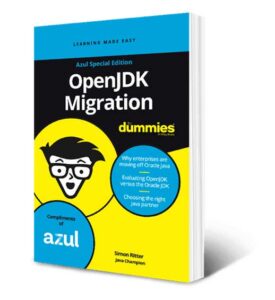
The only constant is change. This seems to be especially true when considering the licensing and pricing of Oracle Java.
Last year, Oracle significantly changed the pricing of its Java SE Subscription support offering. Until January 2023, companies could calculate the price based on the number of CPU cores in use and the number of desktop users. Now, they calculate the price using an employee metric. This is a total of full-time and part-time employees as well as contractors. Then, add any employees of external companies that provide support for your Java applications. This (potentially very large number), multiplied by an Oracle-provided unit cost, can often lead to eye-watering increases in Java licensing costs.
The difference between Oracle’s pricing and Azul’s is striking:
| vCores | Desktops | Employees | Savings with Azul vs Oracle |
|---|---|---|---|
| 250 | 800 | 1,000 | $113,000 |
| 500 | 2,400 | 3,000 | $206,000 |
| 800 | 4,000 | 10,000 | $890,000 |
| 2,000 | 8,000 | 20,000 | $2,395,000 |
Don’t let Oracle Java prices get you in 2025
As Oracle approaches the end of its fiscal year, many users are finding that they are facing substantially higher support renewals than they might have expected. If this is happening to you, make sure 2024 is your last year of overpaying for Oracle Java. By this time in 2025, you should be ready to move to a free OpenJDK distribution or an OpenJDK support subscription.
You have some choices about what to do. Ever since Oracle introduced the licensing that required many users to purchase a Java SE Subscription, there has been a proliferation of OpenJDK distributions, both free and with commercial support.
Request an extension of Oracle’s old pricing model
If you know your Oracle Java contract is coming up for renewal, you may be able to get an extension using the old metrics, essentially buying time to plan and execute your Java migration. If you plan to go this route, use a partner like Palisade Compliance or Miro Consulting.
In a recent webinar, How to Avoid Failing a Java Audit and migrate Your JVMs, Shawn Donohue, vice president of marketing for Miro Consulting, urged caution. “There’s no such thing as a one-year contract. The one-year contract is actually a five-year contract that goes all the way back to 2019. And they will ask for five years, you’re going to pay five years’ worth of price, and you’re only going to get one year going forward. So if your plan is to sit and wait and do nothing, please do not do that because you will not be able to sign that one-year contract. You will lock the lock into five years’ worth, three years at minimum.”
Start preparing now to migrate over the next year
Migrating from the Oracle Java Development Kit (JDK) can be broken down into three stages:
- Discovery: Identify which versions of Java are being used by which applications and on which machines within your organization, including cloud instances. You’ll use this inventory to create a migration plan.
- Execution: For each machine that requires a Java runtime, install the same version (or versions) of the OpenJDK distribution you choose.
- Validation: Test your applications to verify that everything works as expected
Whether or not Oracle grants you the extension, you can begin the discovery phase immediately. The first stage is often the most time-consuming in a JDK migration because of the variety of JDK versions in use. Typically, when a new application is deployed, it uses the latest version of the JDK at that time and continues to use it even as newer versions of Java are released. This is quite logical, because it has been tested with the deployed version.
Often people are not sure how many applications they have that are using or written in Java and are using a JVM. But when they start unpacking the dependencies, they realize that Java is prevalent in core technologies throughout the organization. Working with an IT asset management tool can make this process much easier, and it will set you up to migrate off Oracle Java before the end of Oracle’s next fiscal year.
Users are often concerned that migrating from the Oracle JDK to a build of OpenJDK can be a complicated and costly process. Fortunately, Java is not only open source but has a rigorously defined standard delivered through the Java Community Process (JCP). Each version of the platform has a Java Specification Request (JSR) that provides a precise definition of the language syntax, the JVM functionality and standard libraries that must be present. To confirm that an implementation matches this standard, there is a Technology Compatibility Kit (TCK). This consists of over a hundred thousand tests, all of which must be passed to guarantee conformance.
The Oracle JDK is TCK tested. As long as the distribution you want to move to (like Azul’s Zulu builds of OpenJDK) is also TCK tested, you will have a very high level of confidence that they are functionally equivalent. When you run your application on the Zulu JDK, it will behave and perform exactly as it does on the Oracle JDK. This is what we call a genuine drop-in replacement.
Azul is here to help
Our technologies, as much as it can be, are a drop-in replacement. And when we do migrations, we tend to sort of think about how we can migrate you quickly on what those dependencies look like. But I can tell you now for most of our customers that migrate, some that are more desktop based, they do those migrations in a few days. In fact, one of the world’s biggest bank, migrated 200,000 desktops in a weekend to us all and therefore mitigated that cost of an Oracle
However, the fact that migration is simple and straightforward does not necessarily mean it can be quick. Many organizations have installed a wide variety of JVM-based applications (because they could have been written in languages like Scala and Kotlin, not just Java). This may have happened over decades. Identifying where a JDK has been installed, whether it is in use, and for what applications can be time-consuming.
To help you, Azul has produced the Dummies Guide to OpenJDK Migration. This distils our experiences of helping literally hundreds of customers switch away from the Oracle JDK.
Don’t wait until it’s too late; make sure you plan in advance to avoid a hefty bill for continued safe and secure Java usage. Make this the last year of Oracle Java.





